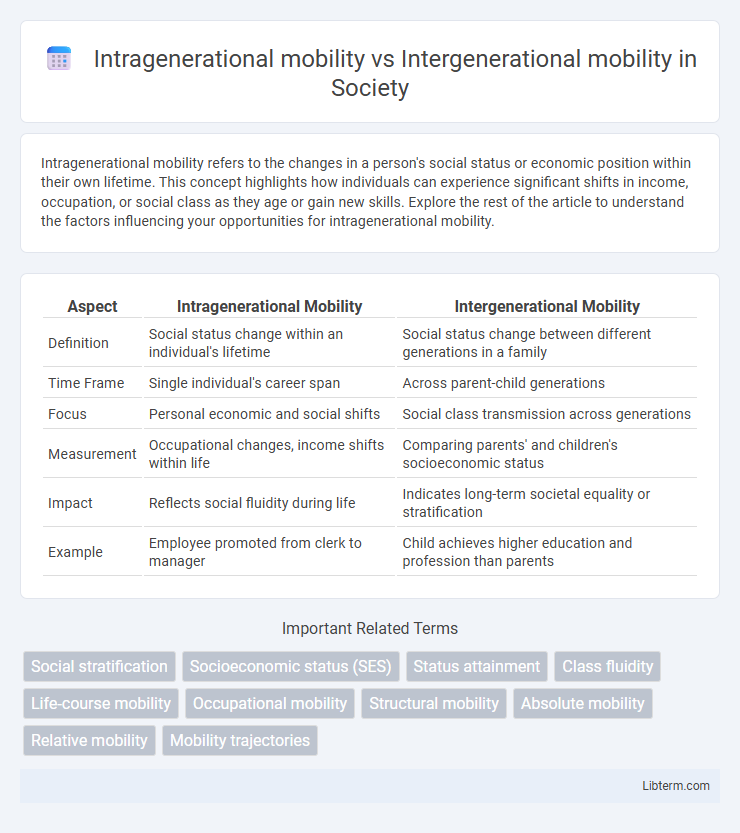Intragenerational mobility refers to the changes in a person's social status or economic position within their own lifetime. This concept highlights how individuals can experience significant shifts in income, occupation, or social class as they age or gain new skills. Explore the rest of the article to understand the factors influencing your opportunities for intragenerational mobility.
Table of Comparison
| Aspect | Intragenerational Mobility | Intergenerational Mobility |
|---|---|---|
| Definition | Social status change within an individual's lifetime | Social status change between different generations in a family |
| Time Frame | Single individual's career span | Across parent-child generations |
| Focus | Personal economic and social shifts | Social class transmission across generations |
| Measurement | Occupational changes, income shifts within life | Comparing parents' and children's socioeconomic status |
| Impact | Reflects social fluidity during life | Indicates long-term societal equality or stratification |
| Example | Employee promoted from clerk to manager | Child achieves higher education and profession than parents |
Understanding Social Mobility: An Overview
Intragenerational mobility refers to changes in an individual's social or economic status within their lifetime, while intergenerational mobility examines social status shifts across generations within a family. Understanding social mobility requires analyzing factors such as education, income, occupation, and societal structures that influence both types of mobility. Empirical studies often highlight how intergenerational mobility measures long-term social equality, whereas intragenerational mobility reflects personal career progression and economic resilience.
Defining Intragenerational Mobility
Intragenerational mobility refers to the changes in an individual's social status or economic position within their own lifetime, contrasting with intergenerational mobility which examines shifts between generations. This form of mobility highlights the dynamic nature of socioeconomic status through career advancements, income changes, or educational attainment over several years. Measuring intragenerational mobility provides insight into social fluidity and the effectiveness of opportunities within a specific society or labor market.
Defining Intergenerational Mobility
Intergenerational mobility measures the changes in social status or economic position between different generations within a family, such as comparing parents' and children's income levels or educational attainment. It highlights the degree to which children can improve or decline relative to their parents' socioeconomic standing, reflecting the fairness and openness of a society. This contrasts with intragenerational mobility, which focuses on social mobility occurring within an individual's lifetime rather than across generations.
Key Differences Between Intragenerational and Intergenerational Mobility
Intragenerational mobility refers to changes in an individual's social or economic status within their own lifetime, highlighting shifts such as career advancement or income change, while intergenerational mobility compares social or economic status differences between parents and their children across generations. Key differences include the time frame--short-term versus long-term impact--and measurement focus, where intragenerational mobility examines personal progress and intergenerational mobility assesses social equality and opportunity across family lines. Studies measure intragenerational mobility through income or occupational changes during a person's career, whereas intergenerational mobility uses metrics like intergenerational income elasticity and educational attainment comparisons.
Factors Influencing Intragenerational Mobility
Factors influencing intragenerational mobility include education level, skill acquisition, and changes in employment sectors, which directly affect an individual's ability to move within the social hierarchy during their lifetime. Economic fluctuations, labor market dynamics, and access to professional networks also play critical roles in determining upward or downward mobility within a single generation. Personal attributes such as adaptability, work ethic, and continuous learning further impact the potential for intragenerational social and economic advancement.
Factors Shaping Intergenerational Mobility
Intergenerational mobility refers to the changes in social status between different generations within a family, while intragenerational mobility describes mobility within an individual's own lifetime. Factors shaping intergenerational mobility include parental education levels, access to quality schooling, economic resources, and social networks, which directly influence children's opportunities for upward mobility. Structural elements like labor market dynamics, social policies, and neighborhood environments also play crucial roles in determining intergenerational mobility outcomes.
Measuring Social Mobility: Tools and Indicators
Measuring social mobility involves assessing both intragenerational mobility, which captures changes in an individual's social status within their lifetime, and intergenerational mobility, comparing social status across generations within families. Tools such as income percentile shifts, occupational status changes, and educational attainment levels are commonly used indicators to quantify mobility patterns. Longitudinal surveys and administrative datasets provide valuable data for tracking movement within social hierarchies, enabling researchers to analyze structural inequality and economic opportunity over time.
Economic Implications of Social Mobility Types
Intragenerational mobility reflects changes in an individual's economic status within their lifetime, affecting income growth and wealth accumulation, which can impact consumption patterns and economic stability. Intergenerational mobility measures the degree to which economic advantages or disadvantages are passed from parents to children, influencing long-term inequality and social stratification. High intergenerational mobility promotes economic dynamism by enabling talent utilization across social classes, while low intragenerational mobility can hinder individual economic advancement and reduce overall economic productivity.
Social Mobility: Case Studies and Comparative Analysis
Intragenerational mobility examines changes in an individual's social status throughout their lifetime, while intergenerational mobility compares the social status between different generations within a family, revealing patterns of economic opportunity and inequality. Case studies such as those from the United States, Sweden, and India highlight varying degrees of social mobility influenced by education systems, labor markets, and welfare policies. Comparative analysis of these studies demonstrates that high intergenerational mobility often correlates with inclusive policies and equitable access to resources, whereas intragenerational mobility tends to be affected by economic shocks and career development opportunities.
Policy Strategies to Enhance Social Mobility
Policy strategies to enhance intragenerational mobility emphasize workforce development, targeted skills training, and access to continuing education to enable upward economic movement within an individual's lifetime. Intergenerational mobility improvement focuses on equalizing educational opportunities, improving early childhood interventions, and reducing income inequality to break cycles of poverty across generations. Effective policies integrate social safety nets, affordable housing, and healthcare access to support both immediate upward mobility and long-term generational advancement.
Intragenerational mobility Infographic

 libterm.com
libterm.com